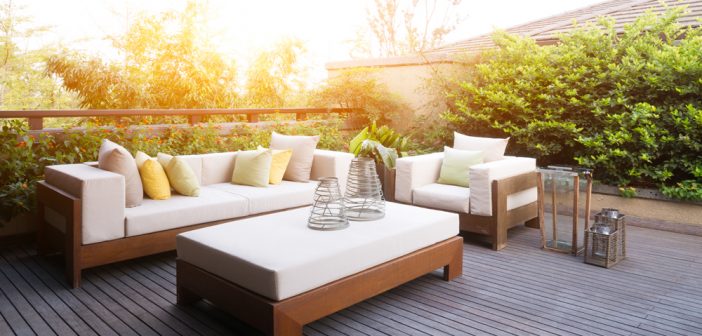Regularly cleaning outdoor furniture is essential if you want an attractive lawn or patio. This task is particularly important after a long, messy winter. Harsh weather can leave lawn furniture and patio sets looking dirty. Follow the tips below and keep your outdoor living space looking beautiful.
How to Get Started
Clearing away loose debris such as leaves, dust and dirt is a great place to begin. Use a dry cloth or brush to wipe away loose materials. After you are finished, spray down plastic, metal, wood, mesh and wicker items to dislodge any surface debris that has managed to linger. Once this is accomplished, clean one group of furniture at a time, based on the material from which it is made.
Plastic
You likely have at least a few pieces of lawn and patio furniture made from resin or plastic. Fortunately, such furniture is not only inexpensive, it is also easy to maintain. Do not use abrasive cleaners on plastic pieces, as this can lead to scuff marks. To keep plastic furniture looking great, simply spray it with an all-purpose cleaner and use a damp cloth or soft sponge to thoroughly wipe it down.
Metal
Stainless steel and wrought iron are popular choices for patio furniture, since it’s easy to maintain and is highly durable. Furniture made from these materials can be made to look like new each spring by simply cleaning the surface with a sponge soaked in water and mild dish soap. As a general rule, add a quarter cup of dish soap to a gallon bucket of water. Warm water works best to clean wrought iron and other types of metal.
Rust is a serious concern if you have metal patio furniture. Although such pieces often have rust-resistant finishes, these coatings wear off over time. If you notice any rust, immediately remove it with steel wool. Consider a new paint job for the furniture in order to prevent similar problems in the future.
Wood
Wood, wicker and teak sometimes take the longest to clean, depending on how much grime and grit has built up on the surface of each piece. Although you may be tempted to power wash this type of furniture, this is not recommended. Power washing may cause surface damage and ruin the look of the furniture. A soft brush or sponge dipped in either soapy water or mild oil soap works best to clean wicker, teak and other types of wood. Mild laundry detergent and warm water is a good example of a proper cleaning formula for these materials. A small brush may be required to remove debris from the tight weave of certain wicker pieces.
Resin
Cleaning lawn furniture made from resin does not have to be difficult task. However, most household cleaners should not be used on a resin surface, as they may cause scratches. Fortunately, dipping a wet sponge in baking soda and gently cleaning in a circular motion will easily remove most stains and dirt from resin furniture. Make sure you rinse each piece well; baking soda can leave a dull film on the surface of the furniture if it is not thoroughly rinsed.
Fabric
Seat cushions, hammocks, and other yard and patio items made from fabric create an inviting atmosphere on your property. However, they get dirty very quickly and dirt tends to cling to these surfaces. Since synthetic and natural materials are used to manufacture these items, the safest way to clean them is with a simple solution of warm water and dish soap. In some cases, the fabric can be removed and washed on the gentle cycle in your washing machine. However, it is important to follow the manufacturer’s instructions regarding washing machine safety. Always air dry these items, hot drying can damage or discolor the fabric. To minimize future staining, consider using a water repellent protector on outdoor furniture that features fabric.
Umbrellas
Always clean umbrellas prior to putting them outside for the season. Keep the umbrella folded down and use a bristled brush to loosen dirt and debris in its folds. After this is accomplished, gently hose the umbrella down to dislodge any remaining leaves or dust. Next, dampen a soft brush and dip it in a bit of laundry soap. Working from top to bottom, run the brush lightly over the canopy and then rinse one final time with your garden hose. Open the umbrella and leave it in a stationary position until it is dry.
Plastic Mesh
Plastic mesh is prone to looking dingy and lackluster after being stored through the winter, therefore your best weapon to clean it is bleach. Mix a quarter cup of bleach and a dash of mild detergent in a full gallon of water and wash each piece thoroughly, then rinse the furniture with your garden hose and allow it to air dry.
Seal Wooden Tables and Chairs
When cleaning your lawn and patio furniture; do not forget to condition wooden pieces with formulas containing natural oils or teak oil. These products are designed to help weatherproof virtually all types of wood finishes. Teak oil and similar formulas also help to prevent rain and sun damage, both of which contribute to dry and wet rot, and graying. There is also a good variety of UV blocking sealants on today’s market, which can be applied on top of other sealants to further protect against sun damage.
Dealing with Mold
Humidity and rain frequently leave outdoor furniture damp, therefore susceptible to mildew and mold. Dealing with mold can be challenging, but it is possible to remove it when the proper approach is taken. Never paint over mold, it will break through the new coat of paint and the problem will get worse. Wash and dry any furniture that has developed mold and allow it air dry. When the surfaces are no longer moist, dry-scrub them with a stiff brush using full strength white vinegar.
Diluted bleach can also be used to remove mold from hard surfaces, but it is not always the best choice as it discolors most materials. It’s always best to use white vinegar, which rarely stains any type of lawn furniture. Of course, vinegar should not be used on fabric-covered patio furniture unless the manufacturer’s instructions state that this is appropriate.









